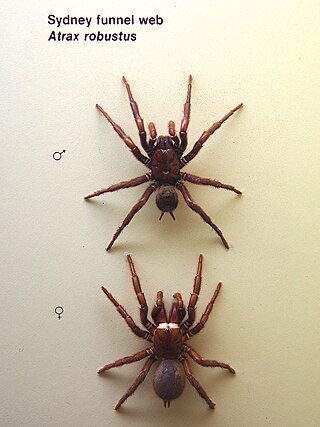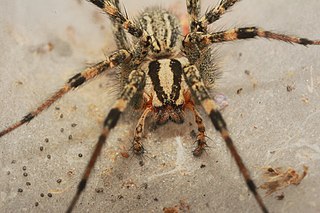
The hobo spider is a member of the family of spiders known colloquially as funnel web spiders, but not to be confused with the Australian funnel-web spider. Individuals construct a funnel-shaped structure of silk sheeting and lie in wait at the small end of the funnel for prey insects to blunder onto their webs. Hobo spiders sometimes build their webs in or around human habitations. Despite past claims, there is no clear evidence that the hobo spider has venom that is dangerous to humans.

Agelenopsis, commonly known as the American grass spiders, is a genus of funnel weavers described by C.G. Giebel in 1869. They weave sheet webs that have a funnel shelter on one edge. The web is not sticky, but these spiders make up for that by running very rapidly. The larger specimens can grow to about 19 mm in body length. They may be recognized by the arrangement of their eight eyes into three rows. The top row has two eyes, the middle row has four eyes, and the bottom row has two eyes. They have two prominent hind spinnerets, somewhat indistinct bands on their legs, and two dark bands running down either side of the cephalothorax.

The Agelenidae are a large family of spiders in the suborder Araneomorphae. Well-known examples include the common "grass spiders" of the genus Agelenopsis. Nearly all Agelenidae are harmless to humans, but the bite of the hobo spider may be medically significant, and some evidence suggests it might cause necrotic lesions, but the matter remains subject to debate. The most widely accepted common name for members of the family is funnel weaver.

The spider species Tegenaria domestica, commonly known as the barn funnel weaver in North America and the domestic house spider in Europe, is a member of the funnel-web family Agelenidae.

Hadronyche formidabilis, the northern tree-dwelling funnel-web spider, is a medically significant mygalomorph spider found in Queensland and New South Wales. It is also known as the Northern Rivers funnel-web spider or northern funnel-web spider.

The Sydney funnel-web spider is a species of venomous mygalomorph spider native to eastern Australia, usually found within a 100 km (62 mi) radius of Sydney. It is a member of a group of spiders known as Australian funnel-web spiders. Its bite is capable of causing serious illness or death in humans if left untreated.

Missulena is a genus of mygalomorph spiders in the family Actinopodidae. It was first described by Charles Walckenaer in 1805, and is a senior synonym of Eriodon. M. tussulena is found in Chile, but the rest are indigenous to Australia. They are sometimes referred to as "mouse spiders" from the now-disproven belief that they dig deep burrows similar to those of mice. Scotophaeus blackwalli is also called a "mouse spider", but it is smaller and not closely related.

Agelenopsis aperta, also known as the desert grass spider or funnel-web spider, is a species of spider belonging to the family Agelenidae and the genus Agelenopsis. It is found in dry and arid regions across the southern United States and into northwestern Mexico. Their body is about 13–18 mm long and they have relatively long legs in order to run after their prey. Desert grass spiders can withstand very low temperatures even though they do not cold harden. It constructs the characteristic funnel-shaped webs in crevices where the funnel will fit, where they wait in the tube for prey which they can run after using their long legs. They often hunt for their prey at night.

Macrothele calpeiana, commonly known as the Gibraltar funnel-web spider or Spanish funnel-web spider, is one of the largest spiders in Europe. Macrothele calpeiana is the only spider species protected under European Union legislation.

Spiders are air-breathing arthropods that have eight limbs, chelicerae with fangs generally able to inject venom, and spinnerets that extrude silk. They are the largest order of arachnids and rank seventh in total species diversity among all orders of organisms. Spiders are found worldwide on every continent except Antarctica, and have become established in nearly every land habitat. As of November 2023, 51,673 spider species in 136 families have been recorded by taxonomists. However, there has been debate among scientists about how families should be classified, with over 20 different classifications proposed since 1900.

Agelena labyrinthica is a species of spider in the family Agelenidae. It is a widespread species in Europe and its range extends to Central and East Asia.

Hadronyche infensa, the Darling Downs funnel-web spider, is a venomous mygalomorph spider, one of a number of Australian funnel-web spiders found in Queensland and New South Wales.

Hadronyche versuta, the Blue Mountains funnel-web spider, is a venomous mygalomorph spider found in central New South Wales.
Hadronyche macquariensis, the Port Macquarie funnel-web spider, is a venomous mygalomorph spider, one of a number of species of Australian funnel-web spiders] found in New South Wales.

Grass spider may refer to:
Illawarra is a monotypic genus of Australian funnel-web spiders containing the single species Illawarra wisharti. It was first described by Michael R. Gray in 2010, and has only been found in the Illawarra region of southern New South Wales. It is a member of the subfamily Atracinae, the Australian funnel-web spiders, a number of whose species produce venom that is dangerous to humans. The generic name comes from the Illawarra region where the spider was found. The species name wisharti honours Graeme Wishart, who collected many mygalomorph spiders in that region.
Susan Elise Riechert is an American behavioral ecologist known for her research in evolutionary biology, evolutionary game theory and the behavior of spiders. She is also known for her "biology in a box" teaching materials, used by hundreds of thousands of elementary and secondary school students in Tennessee.

Agelenopsis emertoni is a species of funnel weaver in the family of spiders known as Agelenidae. It is found in the United States. The spider was named to honour arachnologist James H. Emerton. A. emertoni is distinguished from other Agelenopsis species in the genus by the male's loosely coiling embolus making more than one full circle, and a claw-like conductor tip. These features are sclerites of the male sex organ which is used to inseminate the female. The female has a distinctive conducting tube in her genitalia. The male can be between 6 and 13mm. Distribution is in the following states of the USA: Arkansas, Colorado, Florida, Georgia, Louisiana, Massachusetts, Mississippi, Missouri, New Jersey, New York, North Carolina, Oklahoma, Pennsylvania, Tennessee, Texas, Virginia.
Agelenopsis pennsylvanica, commonly known as the Pennsylvania funnel-web spider or the Pennsylvania grass spider, is a species of spider in the family Agelenidae. The common name comes from the place that it was described, Pennsylvania, and the funnel shape of its web. Its closest relative is Agelenopsis potteri.















